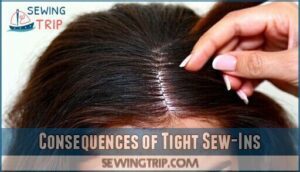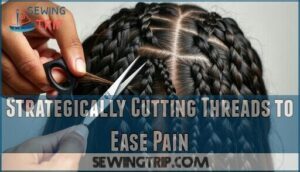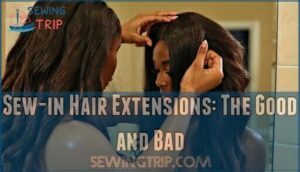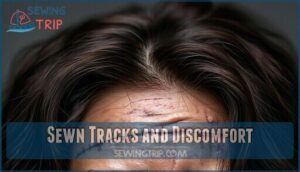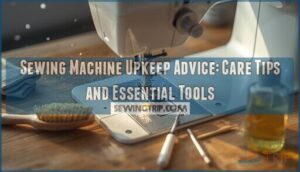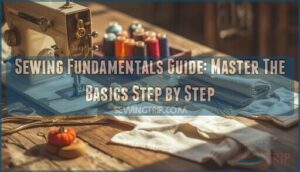This site is supported by our readers. We may earn a commission, at no cost to you, if you purchase through links.
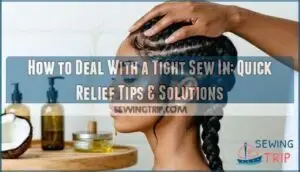
Start by massaging your scalp with fingertips using gentle circular motions—this increases blood flow and reduces tension.
Apply warm oil treatments using coconut, olive, or castor oil to loosen braids naturally.
A steaming towel over oiled scalp works wonders for stubborn tightness.
If pain persists, strategically cut a few threads in the tightest areas, but be careful not to unravel entire tracks.
Communication with your stylist is essential—don’t suffer in silence thinking it’s normal.
Ice packs can provide temporary numbing relief for severe discomfort.
Remember, beauty shouldn’t equal agony.
There are specific oils and techniques that can transform your tight sew-in experience completely.
Table Of Contents
- Key Takeaways
- Signs of a Too-Tight Sew-In
- Consequences of Tight Sew-Ins
- Remedies for Alleviating Tension
- User Experience: Seeking Advice on a Tight Weave
- Sew-in Hair Extensions: The Good and Bad
- Are You Tender Headed?
- 3 Reasons for a Tender Scalp Post Sew-In
- Speak Up! Communication With Stylist
- Beauty is Pain: Will My Hair Extensions Stop Hurting?
- Frequently Asked Questions (FAQs)
- Conclusion
Key Takeaways
- Don’t suffer in silence – Contact your stylist within 24-48 hours if you’re experiencing persistent headaches, scalp bumps, or sleep disruption, as these aren’t normal and require immediate professional adjustment.
- Use soothing oil treatments – Apply warm coconut, olive, or castor oil with gentle scalp massage to increase blood flow and naturally loosen tight braids, then cover with a steaming towel for 10-15 minutes.
- Try strategic thread cutting – If pain persists, carefully cut a few threads in the tightest areas using sharp scissors, but avoid cutting near knots to maintain your style’s integrity.
- Recognize the warning signs – If you can’t sleep comfortably or you’re getting constant headaches beyond 48 hours after installation, your sew-in’s too tight and needs immediate attention to prevent traction alopecia and permanent hair damage.
Signs of a Too-Tight Sew-In
You’ll know your sew-in is too tight if you’re dealing with persistent headaches, scalp bumps, or trouble sleeping through the night.
These warning signs mean your braids and tracks are pulling too hard on your scalp, especially if you’re already tender-headed or dealing with dehydration that makes everything feel worse.
Bumps, Headaches, and Sleeplessness
Why does your head feel like it’s trapped in a vise? Your sew-in is likely too tight, causing scalp tension that disrupts your comfort and sleep.
When your installation creates excessive pressure, your body sends clear warning signals:
- Throbbing headaches around temples and forehead from inflamed follicles
- Tender bumps along your scalp where braids pull too aggressively
- Sleep disruption from constant scalp discomfort and pressure points
- Scalp soreness that worsens with facial expressions or movement
These symptoms signal your hair follicles are under stress. Immediate scalp relief through gentle massage, warm oil treatments, or anti-inflammatory medication can provide temporary headache remedies. However, persistent hair pain beyond 48 hours requires professional adjustment to prevent permanent damage and restore proper sleep solutions.
Sensitivity for Tender-headed Individuals
If you’re tender-headed, a tight sew-in feels like torture. Your scalp becomes hypersensitive to every pull and tug.
Quick scalp relief starts with recognizing your limits:
- Ice packs reduce scalp soreness and inflammation
- Gentle styling prevents additional hair tension
- Tea tree oil soothes scalp sensitivity naturally
- Loose braids minimize tension relief needs
- Professional adjustments address sew-in pain properly
Communicate discomfort immediately—your tender heads deserve better care. Recognizing the need for scalp relief is crucial for overall comfort.
Causes of Tender Scalps (tight Braids, Tightly Sewn Tracks, Dehydration)
Your scalp becomes tender when braids pull too tightly against hair follicles, creating scalp tension that restricts blood flow.
Tightly sewn tracks compound this strain by adding weight and pressure.
Dehydration effects worsen scalp soreness by reducing skin elasticity.
Hair strain from braid damage occurs when your natural hair can’t handle the constant pulling, leading to inflammation and discomfort around the hairline and crown areas.
Consequences of Tight Sew-Ins
Ignoring a tight sew-in won’t make the pain disappear—it’ll create bigger problems for your hair and scalp.
The longer you wait to address excessive tension, the harder it becomes to fix the damage and prevent permanent hair loss.
Breakage and Traction Alopecia
Your sew-in shouldn’t steal your sleep or trigger constant headaches—that’s your scalp crying for help.
Tight installations can trigger hair breakage and traction alopecia, affecting up to one-third of women using protective styles.
When your sew-in pulls constantly, it creates follicular inflammation that leads to gradual hair loss, particularly around your hairline and temples.
You’ll notice the "fringe sign" first—short, broken hairs appearing before bald patches develop.
The weight of extensions combined with excessive tension targets your finest edge hairs, causing scalp damage that becomes permanent if left unchecked.
Early traction relief prevents long-term hair thinning and alopecia progression.
To mitigate this, understanding the effects of hair loss causes and taking preventive measures is key.
Difficulty Addressing Delayed Complaints
When dealing with sew in problems, timing matters more than you’d think.
Delayed relief becomes increasingly difficult as your scalp adjusts to tension patterns.
Pain management grows complex when complaint handling occurs days after installation.
Your stylist faces limited options for sew in removal or adjustments once hair settles into tight positions.
Client feedback delivered immediately allows proper correction techniques.
Waiting transforms minor discomfort into major sew in hair problems requiring complete reinstallation.
Stylist communication within 24-48 hours guarantees effective solutions for your tight sew in concerns, ensuring proper correction and effective solutions for a better experience.
Remedies for Alleviating Tension
When your sew-in feels too tight, you don’t have to suffer through weeks of discomfort.
Several proven remedies can provide quick relief and help restore your scalp’s comfort without compromising your investment.
Using Soothing Oils (peppermint, Tea Tree)
Natural remedies offer powerful oil benefits for scalp relief after tight installations.
Peppermint oil delivers cooling sensation while tea tree remedies reduce inflammation effectively. These solutions provide hair nourishment and address hair scalp sensitivity without harsh chemicals.
Using peppermint oil benefits can enhance the overall hair care experience.
- Dilute properly: Mix 2-3 drops with carrier oil like coconut or jojoba to prevent irritation
- Target application: Use cotton swabs to apply directly on sore spots along your hairline
- Gentle massage: Work oils into scalp using fingertips to boost circulation and hair scalp soothing
- Regular maintenance: Apply every other day as your hair moisturizer for ongoing scalp health support
Moisturizing With a Steaming Towel
Why settle for discomfort when moisture treatment can provide immediate scalp relief? A steaming towel creates the perfect hair hydration environment, delivering targeted towel therapy that loosens tight braids naturally.
Steaming Benefits include:
- Softens rigid braids and tracks
- Increases blood circulation to follicles
- Opens pores for better moisturizing absorption
- Reduces inflammation and tension headaches
Apply your hair moisturizer, then wrap your head with a warm, damp towel for 10-15 minutes, avoiding microwave drying methods. This moisture treatment transforms scalp health instantly, providing immediate scalp relief and promoting hair hydration with targeted towel therapy.
Strategically Cutting Threads to Ease Pain
When thread cutting becomes necessary for pain relief, precision matters most.
Use sharp hair scissors to snip specific threads causing scalp discomfort, targeting areas with visible tension or bumps.
Cut close to the thread while avoiding knots to maintain braid stability, and this sew in maintenance technique provides immediate tension reduction.
Without compromising your style’s integrity or requiring complete removal, this method ensures a stable and comfortable braid, making it a valuable technique for immediate tension reduction.
Seeking Adjustments From The Stylist
When sew-in adjustments become necessary, professional stylist communication guarantees proper braid adjustments without compromising your weave installation.
Contact your stylist immediately if tight sewin causes persistent discomfort.
Experienced professionals can loosen specific tracks, adjust tension points, or perform selective sew-in repair. Don’t attempt complex weave removal yourself—skilled adjustment techniques protect your natural hair while restoring comfort.
Investing in High-quality Hair Extensions
Quality matters when selecting hair extensions for your sew-in installation.
High-quality extensions made from 100% human hair that matches your hair type reduce scalp tension and prevent shedding.
While budgeting options exist, investing in premium extensions guarantees proper hair extension maintenance and comfortable wear.
Quality hair extension installation requires durable fibers that won’t stress your scalp or natural hair during extension care routines.
Using human hair extensions can substantially improve the overall appearance and longevity of your hair.
User Experience: Seeking Advice on a Tight Weave
When your sew-in feels uncomfortably tight, you’re likely experiencing what many women face after installation.
Your sew-in shouldn’t feel like a medieval torture device—comfort and beauty can coexist.
Real user experiences reveal common concerns about thinning hair, scalp pain, and the urgent need for practical solutions that won’t damage your natural hair.
Concerns About Thinning Hair and Scalp Problems
Many women experience hair loss and follicle damage from tight sew-ins that compromise scalp health.
Traction alopecia develops when excessive tension causes hair breakage and thinning edges.
Your scalp irritation signals potential long-term damage. Don’t ignore persistent pain or visible hair thinning around your hairline—these warning signs indicate your follicles are under stress and need immediate attention, as they can lead to traction alopecia and cause hair breakage.
Suggestions to Loosen The Weave or Visit The Stylist for Adjustments
When discomfort persists beyond initial adjustment, don’t suffer in silence.
Contact your stylist immediately for professional weave loosening or stylist adjustments. Most experienced professionals offer hair relief services within the first week.
If your original stylist isn’t available, seek scalp soothers from another qualified technician.
Professional braid relaxers and sew in adjustments can salvage your sew in installation while providing essential hair scalp tension relief for comfortable sew in weave styles.
Prioritizing Scalp Health and Using Oil or Moisturizer
Nourishing your scalp with targeted oil therapy becomes essential when dealing with tight installations.
Regular scalp massage using coconut, jojoba, or castor oil promotes circulation while reducing tension.
Addressing excess oil and yeast can also help alleviate itchiness.
These moisturizer benefits extend beyond immediate relief, supporting long-term scalp health.
Hair serums containing natural ingredients provide additional nourishment, creating ideal conditions for hair growth and comfort during your protective styling journey.
Mention of Icing and Informing The Stylist About Tightness
Cold compresses offer immediate scalp soothing when your sew-in feels unbearably tight.
Apply ice wrapped in cloth for 10-15 minutes to reduce inflammation and numb pain.
However, stylist communication remains your most powerful tool for tightness prevention and long-term hair extension discomfort relief.
- Apply ice wrapped in a thin towel to avoid direct skin contact
- Limit icing sessions to 10-15 minutes to prevent tissue damage
- Focus on the most painful areas along your hairline and crown
- Use cold compresses between scalp treatments for maximum pain management
- Schedule immediate stylist appointments when tight braids cause persistent hair scalp pain
Don’t suffer in silence—your stylist needs honest feedback about discomfort levels.
Effective hair sew in tips include speaking up immediately when tracks feel too tight, rather than enduring unnecessary pain that could damage your natural hair.
This approach helps prevent long-term damage and ensures a more comfortable experience with your hair extensions, emphasizing the importance of immediate action and open communication with your stylist to address any discomfort levels.
Sew-in Hair Extensions: The Good and Bad
Sew-in hair extensions offer incredible styling flexibility, but they’re not without drawbacks.
Understanding both sides helps you make informed decisions about your Hair Care routine.
| Pros | Cons | Considerations |
|---|---|---|
| Versatile styling options | Potential scalp damage | Choose quality Extension Types |
| Length and volume boost | Installation time required | Research Sewing Techniques |
| Protective style benefits | Maintenance commitment | Match your Hair Texture |
| Cost-effective long-term | Risk of traction alopecia | Prioritize Scalp Health |
| Natural hair protection | Sleep discomfort possible | Professional installation is essential |
The key lies in balancing beauty goals with hair health.
Quality sew in installations using proper hair extension care techniques can minimize risks.
However, poor Sewing Techniques or ignoring hair sew in tips often lead to problems.
Your scalp shouldn’t suffer for style – if you’re experiencing hair extension discomfort, it’s time to reassess.
Remember, sew in hair care isn’t just about appearance; it’s about maintaining healthy hair underneath those gorgeous extensions.
Are You Tender Headed?
Understanding whether you have a tender scalp helps determine if your discomfort stems from natural sensitivity or installation issues.
Some people naturally experience more scalp pain due to genetic factors or previous hair treatments.
Here are three key indicators you might be tender-headed:
- Previous sensitivity – You’ve experienced scalp discomfort with braids, ponytails, or Hair Relaxers before
- Quick pain response – Your scalp reacts within hours of any hair tension relief procedures
- Sensitive skin overall – You generally have reactive skin that responds strongly to products or pressure
Honest communication with your stylist about your Tender Heads history guarantees proper Scalp Care techniques.
They can adjust braiding tension, use gentler Sewin Solutions, and recommend specific products for scalp discomfort solutions.
This prevents unnecessary scalp pain and hair scalp tightness issues.
3 Reasons for a Tender Scalp Post Sew-In
You might experience scalp tenderness after your sew-in installation for several specific reasons that go beyond normal adjustment discomfort.
Understanding these three main causes helps you identify whether your discomfort is temporary or requires immediate attention.
Braids and Scalp Tension
Looking beyond surface-level discomfort, tight braids create significant scalp tension that restricts blood flow and inflames hair follicles.
Your cornrows shouldn’t feel like they’re pulling your eyebrows up! This braid tension triggers headaches and soreness, especially around your hairline where follicles face maximum stress.
To alleviate this issue, using proper braid relief products can help reduce tension and promote healthier hair.
| Tension Signs | Relief Methods |
|---|---|
| Throbbing headaches | Scalp massage with oils |
| Pulling at temples | Hair loosening techniques |
| Scalp tenderness | Tension relief treatments |
| Red bumps forming | Braiding techniques adjustment |
| Sleep disruption | Braid removal if severe |
Sewn Tracks and Discomfort
When your stylist pulls those sewn tracks too tight, you’re setting yourself up for serious scalp discomfort.
These tracks create constant pressure against your scalp, restricting blood flow and causing that throbbing sensation.
Tight sewn tracks pull at your hair follicles, leading to hair loss and making every head movement painful.
The tension from these tracks often triggers braid pain that radiates across your entire scalp, making weave removal necessary sooner than expected.
Dehydration and Tender Scalp
Unfortunately, dehydration affects your scalp health more than you’d expect. When your body lacks proper hydration, scalp skin becomes tight and vulnerable to irritation from hair extensions.
Three key dehydration relief strategies include:
- Scalp hydration through daily water intake (8+ cups)
- Hair moisture using coconut or jojoba oils
- Tender care with gentle, moisturizing shampoos
Dehydrated scalps can’t handle extension tension well, making tender scalp issues worse and requiring immediate scalp soothers for relief. Understanding itchy scalp causes is essential for effective relief and maintenance of a healthy scalp.
Speak Up! Communication With Stylist
Your voice matters during sew-in installation—don’t suffer in silence. Speaking up about hair scalp pain prevents long-term damage and guarantees proper hair extension comfort.
Many clients hesitate due to salon etiquette concerns, but effective client communication protects your investment.
- Express discomfort immediately using specific terms like "too tight" or "painful"
- Request tension adjustments during hair consultation before completion
- Document problem areas to discuss during follow-up appointments
Professional stylist feedback shows that 90% of tension issues resolve when addressed early. Quality stylists welcome your input about style preferences and comfort levels.
Remember, sewin installation should enhance your look without compromising scalp health. Open communication with stylist creates better outcomes and builds trust for future services.
Your stylist selection should prioritize professionals who encourage dialogue throughout the process.
Beauty is Pain: Will My Hair Extensions Stop Hurting?
Hair extension pain shouldn’t be your reality.
While some initial discomfort is normal during the first 24-48 hours, persistent scalp pain signals a problem requiring immediate attention.
Your hair follicles and scalp need proper care, not constant stress.
Professional weave removal becomes necessary when pain interferes with sleep or daily activities.
Don’t wait for traction alopecia or permanent damage.
Effective hair extension solutions include loosening tracks, scalp relief treatments with oils, and proper extension aftercare routines.
Pain isn’t beauty—comfort and hair health should coexist in your styling journey.
Frequently Asked Questions (FAQs)
How long should a weave feel tight?
Feeling like your scalp’s in a vice grip after getting your sew-in installed?
A properly installed weave shouldn’t feel tight beyond the first 48 hours.
Any persistent discomfort after this period signals excessive tension that needs immediate adjustment or removal.
How long does it take for a sew in to settle?
Sew-ins typically settle within 3-5 days as your scalp adjusts to the tension.
You’ll notice decreased tightness and improved comfort during this period.
However, severe pain beyond 48 hours signals it’s too tight.
Is it normal for a sew-in to hurt?
Like red flags waving, constant pain isn’t normal.
Some initial tension settles within 48 hours, but persistent headaches, scalp soreness, or sleeping difficulties signal your sew-in’s too tight and needs immediate adjustment to prevent further discomfort, with constant pain being a key indicator of a problem.
How long should sew-in discomfort last?
Normal discomfort typically lasts 24-48 hours after installation. If you’re still experiencing pain, headaches, or scalp tenderness beyond three days, your sew-in’s too tight and needs professional adjustment immediately.
Can I wash hair with tight sew-in?
You’re walking a tightrope with that tight sew-in! Yes, you can wash it, but stick to gentle, lukewarm water and avoid aggressive scrubbing that’ll worsen scalp tension.
Should I sleep differently with new sew-in?
Yes, you’ll want to adjust your sleeping position for the first few nights.
Sleep on your back or use a silk pillowcase to reduce friction.
Elevate your head slightly with an extra pillow to minimize tension on tight braids and tracks.
What hairstyles avoid sew-in tension issues?
Choose looser protective styles like loose box braids, twist-outs, or low buns. Avoid tight cornrows, sleek ponytails, and pulled-back edges. Request gentle tension during installation and communicate discomfort immediately.
How often should sew-ins be redone?
Like switching from dial-up to broadband, you’ll want to refresh your sew-in every 6-8 weeks.
This timeframe prevents excessive tension buildup, maintains your natural hair’s health, and keeps your style looking fresh without compromising scalp comfort.
It is essential to follow this schedule to ensure your sew-in remains comfortable and fresh.
Conclusion
Consider your scalp like a delicate garden—it needs proper care to thrive, not aggressive tension that stunts its growth.
When learning how to deal with a tight sew in, remember that your comfort matters more than temporary beauty standards.
You’ve got effective remedies at your disposal: warming oils, gentle massage, strategic thread cutting, and honest communication with your stylist.
Don’t endure unnecessary pain thinking it’s normal, your hair and scalp deserve better treatment, and taking quick action prevents long-term damage while maintaining your desired look.
- https://www.google.com/chrome/
- https://www.dovepress.com/traction-alopecia-the-root-of-the-problem-peer-reviewed-fulltext-article-CCID
- https://pmc.ncbi.nlm.nih.gov/articles/PMC8530059/
- https://healthhub.cpcmg.net/docs/hair-loss-from-tight-hair-style
- https://tarahair.com/blogs/news/can-sew-in-extensions-damage-my-natural-hair-tips-to-keep-your-locks-healthy

